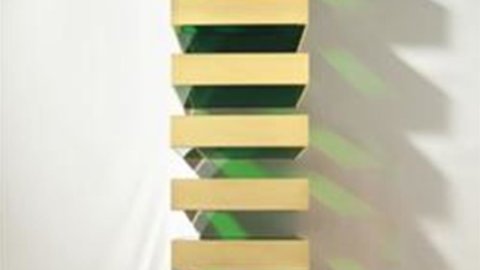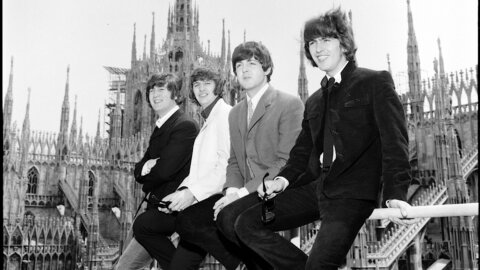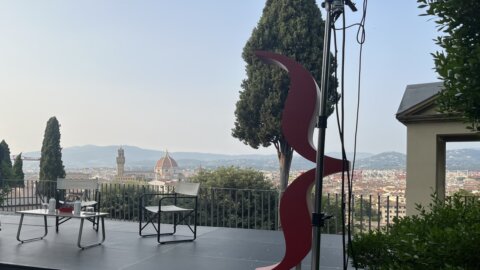Christie’s announce the sale of Donald Judd’s Untitled (Bernstein 93-1) as one of the highlights of the fall auction season. The fifteen foot high sculpture will be included in the Evening Sale of Post-War and Contemporary Art on Wednesday, November 12. In scale, design, radiance, effect and simplicity, Untitled (Bernstein 93-1) is one of the most important works by the artist to be presented on the market and confirms Donald Judd’s position as a master of Minimalist art. Untitled (Bernstein 93-1) was executed a few months before the artist’s death; this magnificent sculpture, one of the artists large scale stack sculptures, has remained in the same collection since its creation in 1993.
Donald Judd’s Untitled (Bernstein 93-1), is an icon of 20th century sculpture, and one of the artists most important and recognizable works. Judd’s approach to sculpture was truly revolutionary, using industrial materials and pared-down geometric forms that equally stressed the physical structure and the space around it. Resolutely anti-illusionistic, his sculpture used abstraction to explore issues of sensation and perception. Untitled (Bernstein 93-1) is a superb example of Judd’s seminal group of works known as stacks, which he began in 1965, this monumental work is composed of ten rectangular units of brass and colored Plexiglas.
“Donald Judd’s Stacks are arguably the most successful, recognizable and transcendent pieces within his significant body of work. Judd’s visual vocabulary, pared down to its essentials, allowed for a wide variety of expressive material combinations. Untitled (Bernstein 93-1) pairs the warmth of brass and its intense golden color with a uniquely serene green Plexiglas. There is a particular harmony within this striking combination that equally promotes the artist’s primary concerns with material, space and color. There has been a steady increase in market appreciation for Judd’s most important and brilliantly realized works. There is no doubt that Untitled (Bernstein 93-1) will capture the full attention of International collectors, when it will be offered at Christie’s this November 12. This masterwork, which could break the current record for the artist at auction, is available on the market for the first time since its original acquisition in 1993,” states Jonathan Laib, Senior Specialist, Post-War and Contemporary Art.
The stack became an important motif to which Judd returned throughout his career, a form that evidently allowed him to explore how different combinations of color and materiality could inform his spatial concepts. In its juxtaposition of rigid form and transparency, Plexiglas blurs the line between the positive space of Judd’s objects and the negative space interspersed in between. Indeed the transparent quality of Plexiglas informs the material object as well as the negative space through its emission of an ethereal glow. Plexiglas was a material that held special resonance for the artist in its ability to embody a multitude of industrial-grade colors. Judd turned to Plexiglas for its spotless luminosity and clear-cut sharpness and for its ability to transmit color without betraying its mode of manufacture.
More so than any other material in Judd’s repertoire, because of its ability to become any color and any degree of transparency and opacity, Plexiglas lived up to the artist’s stipulation that material and color should form a single entity, making it a favored material to combine with different metals in his stacks. Preferring to leave the surfaces of his materials unaltered in an effort to present something of their own nature, Plexiglas offered Judd a most effective way to do this, by presenting a colored material that is free of any trace of manual intervention. As explained by Judd, “the piece should never be, as in Abstract Expressionism, a spectacle of its making; it should just be there” (D. Judd, quoted in Donald Judd, exhibition catalogue, Pace Wildenstein, New York, 2004, p. 8). Through the interaction between the strong green radiant color of the Plexiglas coupled with the polished golden brass, Untitled (Bernstein 93-1), is an incredibly complex and nuanced composition in the largest scale format.
Donald Judd is one of the most important and influential artists of the 20th century, whose ideas and work changed the course of modern sculpture. His art is form condensed to its main essence, which he expressed in a reductive language of pristine forms, bold colors, exacting proportions and a precise manipulation of space. Although Judd particularly favored industrial materials – steel, Plexiglas, plywood – the appearance of his sculpture is extremely human, exuding a sense of classical beauty that is brought about by the tactile and personal nature of the work but also by its symmetrical qualities.
“I long ago reached an agreement with what I consider the primary condition: art, for myself, and architecture, for everyone, should always be symmetrical except for a good reason,” Judd stated in 1985. In his combining of the artist/craftsman role, and his unwavering focus on space, Judd brings to mind the medieval cathedral builders, steadily creating and occupying space in the most equilibrated of ways. “Space is made by an artist or architect; it is not found and packaged. It is made by thought … Sometimes when they [people] are traveling they enter a cathedral, recognize space, and thank God instead of the architect … Space is so unknown that the only comparison is to the beliefs of the past,” Judd declared in 1993 in what would be his last essay ‘Some Aspects of Color in General and Red and Black in Particular.’
Note to the Editors:
Christie’s is the leader for Post-War and Contemporary Art worldwide, and holds the highest prices for any works of art sold at auction and sale totals. The Evening sale of Post-War and Contemporary Art, on May 13, 2014, totaled $744,944,000 – the highest auction total in art market history. On May 2006, Christie’s Post-War & Contemporary Art organized an outstanding exhibition and auction titled Donald Judd: Selected Works from the Judd Foundation, with an ensemble of 35 pieces that reflected the full scope of the artist’s career. The proceed of the sale, which realized $27,788,400, allowed the Foundation to create the endowment necessary to work towards the realization of Donald Judd’s vision for the Foundation and to preserve the 16 permanently installed spaces in New York and Marfa, Texas.
Christie’s holds the 3 highest prices realized for the artist at auction:
Untitled (DSS 42), 1963
Light cadmium red oil and black oil on wood w/galvanized iron and aluminum
New York, November 12, 2013
Sold For $14,165,000
World Auction Record for the artist
Untitled (Bernstein 89-24), 1989
Medium copper and red Plexiglas
New York, November 14, 2012
Sold For $10,162,500
Untitled (77-41 Bernstein), 1977
Medium galvanized iron and transparent blue plexiglas
New York, May 16, 2007
Sold For $9,840,000
Preview:
New York: 1 – 5 November 2014
Viewing:
New York: 8 – 12 November 2014
Auction:
New York: 12 November 2014 at 7pm
Christie’s 20 Rockefeller Plaza
Image Christie’s: Donald Judd (1928-1994) Untitled (Bernstein 93-1) brass and green Plexiglas ten elements – each: 9 x 40 x 31 in. (22.9 x 101.6 x 78.7 cm.) overall: 180 x 40 x 31 in. (457.2 x 101.6 x 78.7 cm.) Executed in 1993. Estimate: $7,000,000-9,000,000.





